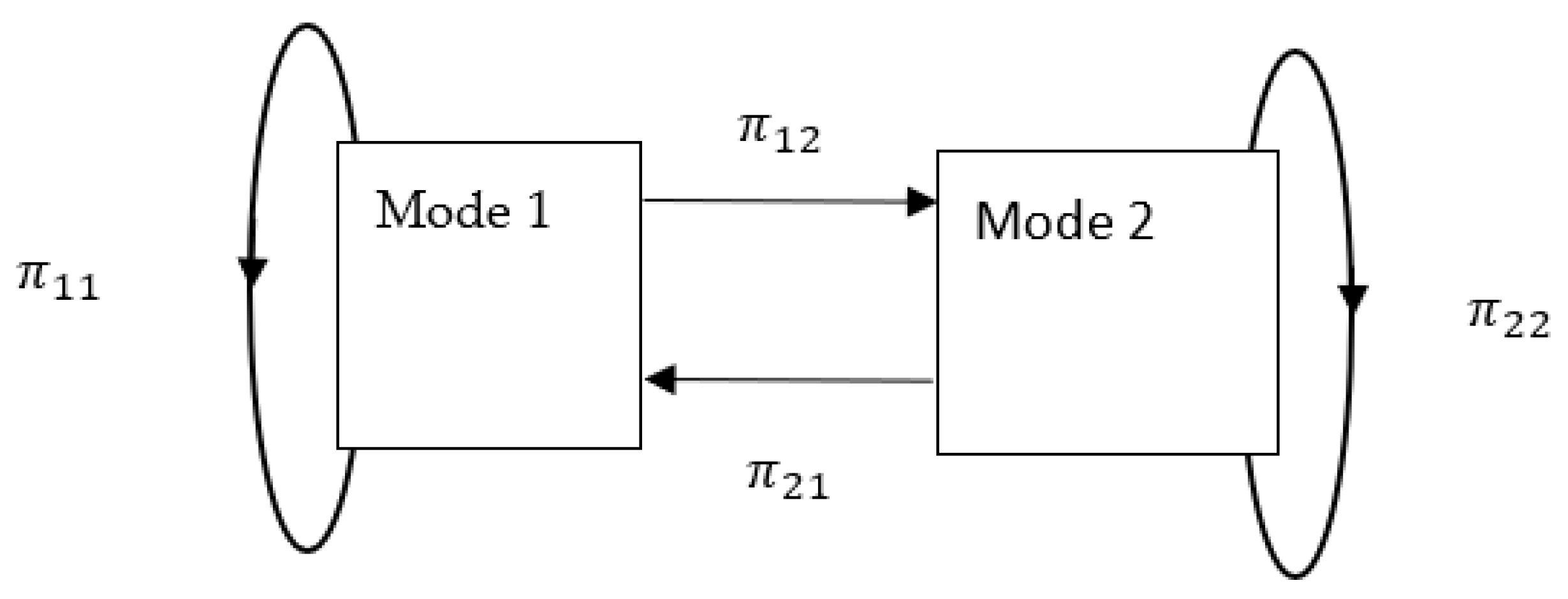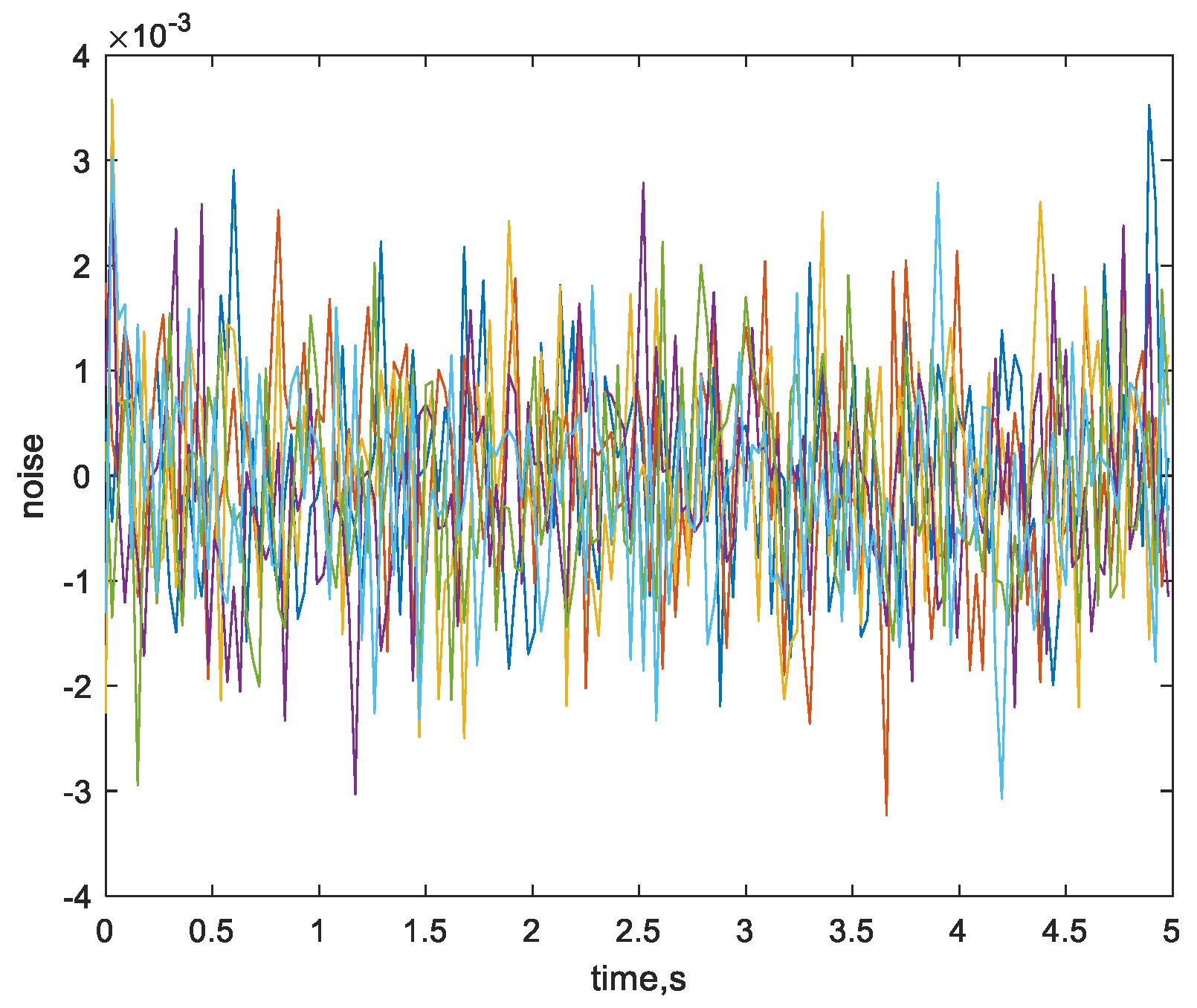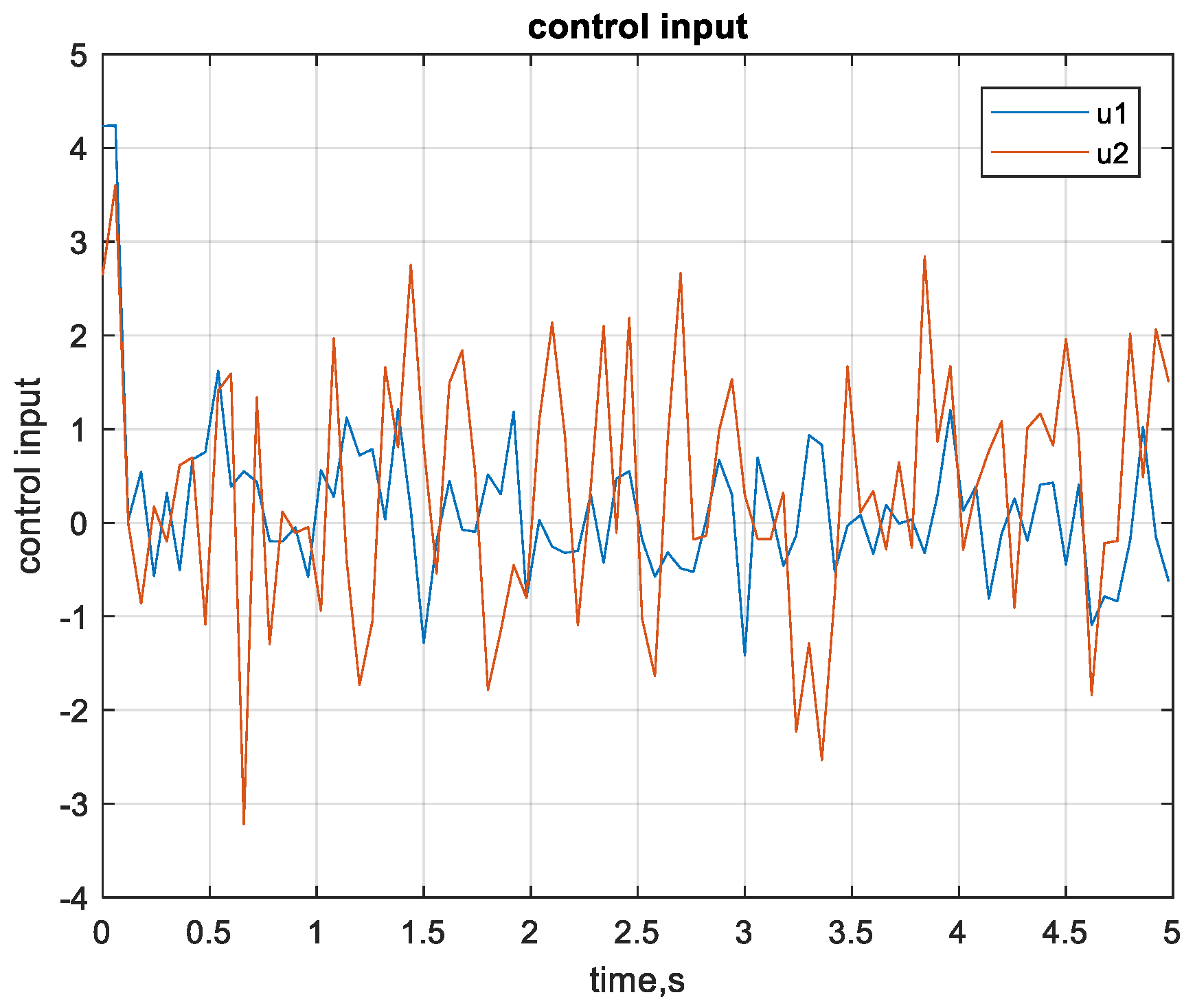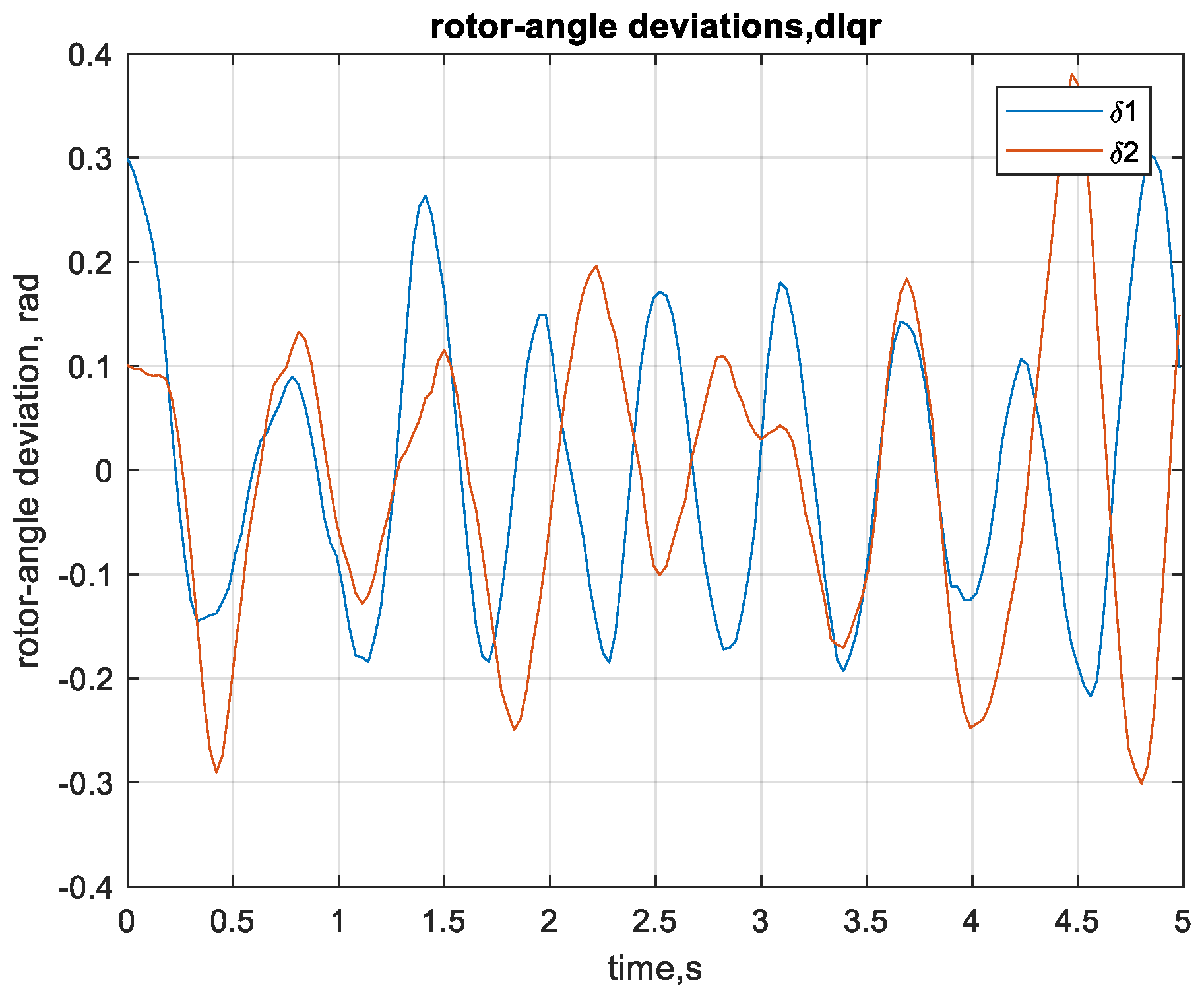Ellipsoidal Design of Robust Stabilization for Markov Jump Power Systems under Normal and Contingency Conditions
Abstract
:1. Introduction
- (1)
- The two transmission line fails/fixed modes are described as a discrete-time Markov chain.
- (2)
- The attracting ellipsoid approach [27], a powerful method in robust control theory, is used to offer a new optimal excitation control design.
- (3)
- The stochastically mean-square stability and solvability of control gains in power systems vulnerable to random topological changes are investigated using the Lyapunov function.
- (4)
- The proposed control can be easily applied using simple logic to select the relevant controller according to the mode of operation.
2. Stochastic Modeling and Problem Formulation
3. Ellipsoidal Controller Design for MJPS
4. Reliability Analysis
Reliability of the Study System
5. Results: Simulation Validation
5.1. Testing the Proposed Controller at Nominal Loads with Line Fixed/Fails Modes
I. Mode 1, normal operation (no failure, line L3 fixed)
II. Mode 2, least reliable operation (line 5–6, L3 fails)
5.2. Comparison with Linear Optimal Excitation Control (LOEC)
5.3. Robustness Testing of the Proposed Controller against over/under Loads and Line Fixed/Fails Modes
6. Conclusions
- Power systems subject to normal and repair/failure modes and random noise (representing parameter uncertainties, e.g., line reactance depends on the spacing of conductors, which depends on wind speed variations) are considered.
- Discrete-time Markov jumps are used to model the resulting transmission line fixed/repair modes.
- The innovative power system excitation control is based on a derived sufficient condition in the framework of linear matrix inequalities (LMIs) and the attracting ellipsoid method. The proposed controller is robust against such stochastic uncertainties and load changes.
- The suggested controllers switch between the two random modes, i.e., line fixed/repair. They are easy to implement by using simple logic to select the relevant controller according to the mode.
Author Contributions
Funding
Institutional Review Board Statement
Informed Consent Statement
Data Availability Statement
Conflicts of Interest
Nomenclature
Appendix A. Linear State Equation for Multi-Machine System
References
- Sauer, P.W.; Pai, M.A.; Chow, J.H. Power System Dynamics and Stability With Synchrophasor Measurement and Power System Toolbox, 2nd ed.; John Wiley & Sons Ltd.: Hoboken, NJ, USA, 2018. [Google Scholar]
- Soliman, H.M.; Elshafei, A.L.; Shaltout, A.A.; Morsi, M.F. Robust power system stabilizer. Proc. Inst. Elect. Eng. Gen. Transm. Distrib. 2000, 147, 285–291. [Google Scholar] [CrossRef]
- Ray, P.K.; Paital, S.R.; Mohanty, A.; Eddy, F.Y.S.; Gooi, H.B. A Robust power system stabilizer for enhancement of stability in power system using adaptive fuzzy sliding mode control. Appl. Soft Comput. 2018, 73, 471–481. [Google Scholar] [CrossRef]
- Shokouhandeh, H.; Jazaeri, M. Robust design of fuzzy-based power system stabilizer considering uncertainties of loading conditions and transmission line parameters. IET Gen. Transm. Distrib. 2019, 13, 4287–4300. [Google Scholar] [CrossRef]
- Butti, D.; Mangipudi, S.K.; Rayapudi, S.R. Design of robust modified power system stabilizer for dynamic stability improvement using Particle Swarm Optimization technique. Ain Shams Eng. J. 2019, 10, 769–783. [Google Scholar]
- Alshammari, B.M.; Guesmi, T. New Chaotic Sunflower Optimization Algorithm for Optimal Tuning of Power System Stabilizers. J. Electr. Eng. Technol. 2020, 15, 1985–1997. [Google Scholar] [CrossRef]
- Bandal, V.; Bandyopadhyay, B. Robust decentralized output feedback sliding mode control technique-based power system stabilizer (PSS) for multimachine power system. IET Control Theory Appl. 2007, 1, 1512–1522. [Google Scholar] [CrossRef]
- Soliman, H.M.; Ghommam, J. Reliable control of power systems. In Diagnosis, Fault Detection & Tolerant Control; Springer: Berlin/Heidelberg, Germany, 2020. [Google Scholar]
- Lee, H.J.; Park, J.B.; Joo, Y.H. Robust load-frequency control for uncertain nonlinear power systems: A fuzzy logic approach. Inf. Sci. 2006, 176, 3520–3537. [Google Scholar] [CrossRef]
- Jin, L.; Zhang, C.K.; He, Y.; Jiang, L.; Wu, M. Delay-dependent stability analysis of multi-area load frequency control with enhanced accuracy and computation efficiency. IEEE Trans. Power Syst. 2019, 34, 3687–3696. [Google Scholar] [CrossRef]
- Shang-Guan, X.; He, Y.; Zhang, C.; Jiang, L.; Spencer, J.W.; Wu, M. Sampled-data based discrete and fast load frequency control for power systems with wind power. Appl. Energy 2020, 259, 114202. [Google Scholar] [CrossRef]
- Dey, R.; Ghosh, S.; Ray, G.; Rakshit, A. H∞ load frequency control of interconnected power systems with communication delays. Int. J. Electr. Power Energy Syst. 2012, 42, 672–684. [Google Scholar] [CrossRef]
- Su, X.; Liu, X.; Song, Y.D. Event-triggered sliding-mode control for multi-area power systems. IEEE Trans. Ind. Electron. 2017, 64, 6732–6741. [Google Scholar] [CrossRef]
- Tian, E.; Peng, C. Memory-based event-triggering H∞ load frequency control for power systems under deception attacks. IEEE Trans. Cybern. 2020, 50, 4610–4618. [Google Scholar] [CrossRef] [PubMed]
- Ali, M.S.; Agalya, R.; Shekher, V.; Joo, Y.H. Non-fragile sampled data control for stabilization of non-linear multi-agent system with additive time varying delays, Markovian jump and uncertain parameters. Nonlinear Anal. Hybrid Syst. 2020, 36, 100830. [Google Scholar] [CrossRef]
- Rakkiyappan, R.; Maheswari, K.; Sivaranjani, K.; Joo, Y.H. Nonfragile finite-time l2—l∞ state estimation for discrete-time neural networks with semi-Markovian switching and random sensor delays based on Abel lemma approach. Nonlinear Anal. Hybrid Syst. 2018, 29, 283–302. [Google Scholar] [CrossRef]
- Li, F.; Xu, S.; Shen, H.; Ma, Q. Passivity-based control for hidden Markov jump systems with singular perturbations and partially unknown probabilities. IEEE Trans. Autom. Control 2020, 65, 3701–3706. [Google Scholar] [CrossRef]
- Ugrinovskii, V.A.; Pota, H.R. Decentralized control of power systems via robust control of uncertain Markov jump parameter systems. Int. J. Control 2005, 78, 662–677. [Google Scholar] [CrossRef]
- Soliman, H.M.; Shafiq, M. Robust stabilisation of power systems with random abrupt changes. IET Gen. Transm. Distrib. 2015, 9, 2159–2166. [Google Scholar] [CrossRef]
- Kaviarasan, B.; Sakthivel, R.; Kwon, O.M. Robust fault-tolerant control for power systems against mixed actuator failures. Nonlinear Anal. Hybrid Syst. 2016, 22, 249–261. [Google Scholar] [CrossRef]
- Poznyak, A.S.; Alazki, H.; Soliman, H.M. Soliman Invariant-set Design of Observer-based Robust Control for Power Systems Under Stochastic Topology and Parameters Changes. Int. J. Electr. Power Energy Syst. 2021, 131, 107112. [Google Scholar] [CrossRef]
- Soliman, H.M.; Alazki, H.; Poznyak, A.S. Robust Stabilization of Power Systems Subject to a Series of Lightning Strokes Modeled by Markov Jumps: Attracting Ellipsoids Approach. J. Frankl. Inst. 2022, 359, 3389–3404. [Google Scholar] [CrossRef]
- Kuppusamy, S.; Joo, Y.H.; Kim, H.S. Asynchronous Control for Discrete-Time Hidden Markov Jump Power Systems. IEEE Trans. Cybern. 2021, 52, 9943–9948. [Google Scholar] [CrossRef] [PubMed]
- Alexopoulos, T.A.; Manousakis, N.M.; Korres, G.N. Fault Location Observability using Phasor Measurements Units via Semidefinite Programming. IEEE Access 2016, 4, 5187–5195. [Google Scholar] [CrossRef]
- Theodorakatos, N.P.; Manousakis, N.M.; Korres, G.N. Optimal placement of phasor measurement units with linear and non-linear models Electr. Power Compon. Syst. 2015, 43, 357–373. [Google Scholar] [CrossRef]
- Meliopoulos, A.S.; Cokkinides, G.J.; Wasynczuk, O.; Coyle, E.; Bell, M.; Hoffmann, C.; Nita-Rotaru, C.; Downar, T.; Tsoukalas, L.; Gao, R. PMU Data Characterization and Application to Stability Monitoring. In Proceedings of the 2006 IEEE PES Power Systems Conference and Exposition, Montreal, QC, Canada, 18–22 June 2006; pp. 151–158. [Google Scholar] [CrossRef]
- Poznyak, A.; Polyakov, A.; Azhmyakov, V. Attractive Ellipsoids in Robust Control; Springer International Publishing: Cham, Switzerland, 2014. [Google Scholar]
- Saadat, H. Power System Analysis, 3rd ed.; PSA Publishing: North York, NY, USA, 2010. [Google Scholar]
- Tuckwell, H.C. Elementary Applications of Probability Theory with an Introduction to Stochastic Differential Equations, 2nd ed.; Chapman & Hall/CRC: Boca Raton, FL, USA, 1995. [Google Scholar]
- Kay, S.M. Intuitive Probability and Random Processes Using Matlab; Springer: Berlin/Heidelberg, Germany, 2006. [Google Scholar]
- Awad, H.; Bayoumi, E.H.E.; Soliman, H.M.; De Santis, M. Robust Tracker of Hybrid Microgrids by the Invariant-Ellipsoid Set. Electronics 2021, 10, 1794. [Google Scholar] [CrossRef]
- Billinton, R.; Allan, R. Reliability Evaluation of Engineering Systems: Concepts and Techniques, 2nd ed.; Springer Science+Business Media: New York, NY, USA, 1992. [Google Scholar]
- El-Sheikhi, F.A.; Soliman, H.M.; Ahsan, R.; Hossain, E. Regional Pole Placers of Power Systems Under Random Failures/Repair Markov Jumps. Energies 2021, 14, 1989. [Google Scholar] [CrossRef]
- Lu, Q.; Sun, Y.; Mei, S. Nonlinear Control Systems and Power System Dynamics; Kluwer Academic Publishers: Norwell, MA, USA, 2001. [Google Scholar]











| Bus # | 1 | 2 | 3 | 4 | 5 | 6 |
|---|---|---|---|---|---|---|
| Gen-(MW) | - | 150 | 100 | - | - | - |
| Load-(MW) | - | - | - | 100 | 90 | 160 |
| Load-(MVAr) | - | - | - | 70 | 30 | 110 |
| 0.80 | 1.30 | 0.90 | - | - | - | |
| 0.80 | 1.30 | 0.90 | - | - | - | |
| 0.20 | 0.15 | 0.25 | - | - | - | |
| 9 | 5.80 | 6 | - | - | - | |
| H | 20 | 4 | 5 | - | - | - |
| AVR parameters | ||||||
| Ka | 25 | 25 | 25 | - | - | |
| Ta | 0.05 | 0.05 | 0.05 | - |
| From Bus # | To Bus # | R(p.u) | X(p.u) | 0.5B(p.u) |
|---|---|---|---|---|
| 1 | 4 | 0.035 | 0.225 | 0.0065 |
| 1 | 5 | 0.025 | 0.105 | 0.0045 |
| 1 | 6 | 0.04 | 0.215 | 0.0055 |
| 2 | 4 | 0.0 | 0.035 | 0.0 |
| 3 | 5 | 0.0 | 0.042 | 0.0 |
| 4 | 6 | 0.028 | 0.125 | 0.0035 |
| 5 | 6 | 0.026 | 0.175 | 0.03 |
| All Lines Are Available | Line 1 Is on Outage | Line 2 Is on Outage | Line 3 Is on Outage | Line 4 Is on Outage | Line 5 Is on Outage |
|---|---|---|---|---|---|
| 0.983116 | 0.982902 | 0.982902 | 0.974569 | 0.982902 | 0.982902 |
| System Reliability Condition | State 1 | State 2 |
|---|---|---|
| Highest | 0.99943 | 0.00057 |
| Lowest | 0.067 | 0.933 |
Publisher’s Note: MDPI stays neutral with regard to jurisdictional claims in published maps and institutional affiliations. |
© 2022 by the authors. Licensee MDPI, Basel, Switzerland. This article is an open access article distributed under the terms and conditions of the Creative Commons Attribution (CC BY) license (https://creativecommons.org/licenses/by/4.0/).
Share and Cite
Soliman, H.M.; El-Sheikhi, F.A.; Bayoumi, E.H.E.; De Santis, M. Ellipsoidal Design of Robust Stabilization for Markov Jump Power Systems under Normal and Contingency Conditions. Energies 2022, 15, 7249. https://doi.org/10.3390/en15197249
Soliman HM, El-Sheikhi FA, Bayoumi EHE, De Santis M. Ellipsoidal Design of Robust Stabilization for Markov Jump Power Systems under Normal and Contingency Conditions. Energies. 2022; 15(19):7249. https://doi.org/10.3390/en15197249
Chicago/Turabian StyleSoliman, Hisham M., Farag A. El-Sheikhi, Ehab H. E. Bayoumi, and Michele De Santis. 2022. "Ellipsoidal Design of Robust Stabilization for Markov Jump Power Systems under Normal and Contingency Conditions" Energies 15, no. 19: 7249. https://doi.org/10.3390/en15197249






